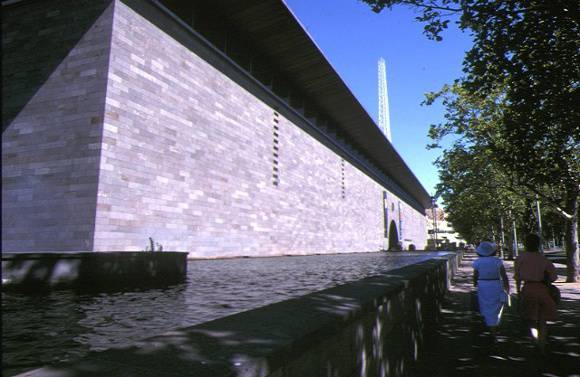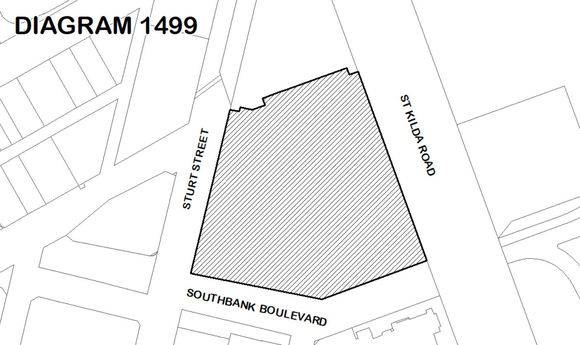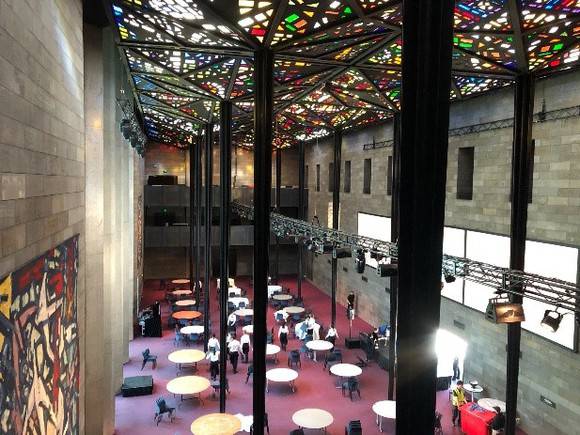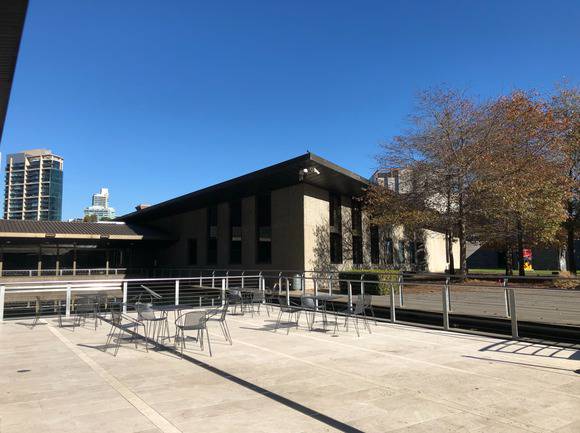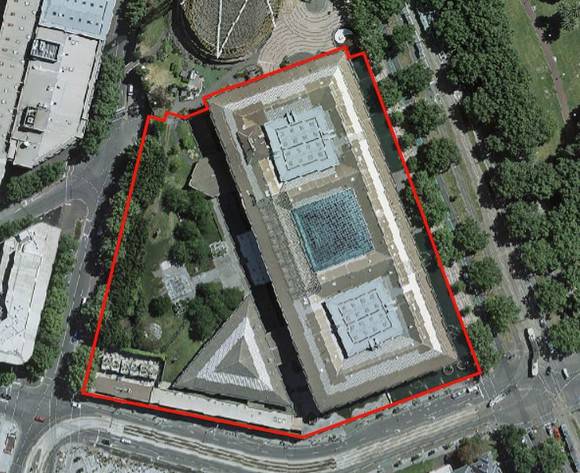| Back to search results » | Back to search page » |
|
NATIONAL GALLERY OF VICTORIA
Other NamesNGV , NGV International , NGV St Kilda Road , NGVI , National Gallery Location180 ST KILDA ROAD SOUTHBANK, MELBOURNE CITY
File NumberFOL/15/36802 [ 1 - 2 ]LevelRegistered |
|
Statement of Significance
What is significant?
The National Gallery of Victoria (NGV International) designed by Roy Grounds and opened in 1968 is of cultural heritage significance to the State of Victoria. The external form and fabric of the main gallery building, former art school building and their landscaped surrounds are significant, as is the remaining original form and fabric of the interior. Artworks and design features commissioned for the building including the Leonard French stained-glass ceiling to the Great Hall, water wall fronting St Kilda Road and coat of arms designed by Norma Redpath are significant. Furniture designed for the building by Grant and Mary Featherston is also significant.
How is it significant?
The National Gallery of Victoria is of historical, architectural, aesthetic and social significance to the State of Victoria. It satisfies the following criterion for inclusion in the Victorian Heritage Register:
Criterion A
Importance to the course, or pattern, of Victoria’s cultural history.
Criterion D
Importance in demonstrating the principal characteristics of a class of cultural places and objects
Criterion E
Importance in exhibiting particular aesthetic characteristics.
Criterion G
Strong or special association with a particular present-day community or cultural group for social, cultural or spiritual reasons.
Criterion H
Special association with the life or works of a person, or group of persons, of importance in Victoria’s history.
Criterion A
Importance to the course, or pattern, of Victoria’s cultural history.
Criterion D
Importance in demonstrating the principal characteristics of a class of cultural places and objects
Criterion E
Importance in exhibiting particular aesthetic characteristics.
Criterion G
Strong or special association with a particular present-day community or cultural group for social, cultural or spiritual reasons.
Criterion H
Special association with the life or works of a person, or group of persons, of importance in Victoria’s history.
Why is it significant?
The National Gallery of Victoria is historically significant as one the largest civic works undertaken in Victoria in the fifty years following World War I. It was the first stage of the broader Arts Centre complex, one of the most ambitious civic building projects undertaken in Victoria. It provided Melbourne with its first major, purpose-built art gallery. When it opened in 1968 it set new standards for exhibition layout, art storage and conservation and represented a new era in the arts and public architecture. Apart from a closure for refurbishment from 1999–2003, the National Gallery of Victoria has operated continuously since 1968 becoming a primary focus for the arts in Victoria and has provided Melbourne with an important landmark and visual image. [Criterion A]
The National Gallery of Victoria is architecturally and aesthetically significant as one of Victoria’s most notable modernist buildings. Highly ambitious and original, it is a major work of Roy Grounds, one of Australia’s most eminent modernist architects. Its monumental scale, wide expanses of bluestone, extensive moats and bold geometric form make a powerful architectural statement. It is significant for its highly detailed and considered design, which integrated artworks such as the Leonard French stained-glass ceiling in the Great Hall, coat of arms by sculptor Norma Redpath and furniture designed by Grant and Mary Featherston. Redeveloped by Mario Bellini and Metier3 in 1999–2003 the building retains its iconic status and landmark qualities. The building received recognition from the Royal Australian Institute of Architects both on its completion and in 2012. [Criterion D and E]
The National Gallery of Victoria is socially significant as Victoria’s premier art gallery. Since its opening in 1968 it has been valued by people across the State who have shared experiences and memories of the place. The strength of public attachment to the place is demonstrated by the extent of public support and donations for its establishment, its consistently high visitor numbers and the strong community reaction to the proposed change to the place in the late 1990s. Sensory experiences such as touching the water wall and lying down gazing up at the Leonard French ceiling are part of its social resonance, which has in some cases become multi-generational. As Victoria’s pre-eminent art gallery, the place has particular social significance for those involved with the arts in Victoria. [Criterion G]
The National Gallery of Victoria is significant for its association with eminent architect Roy Grounds. The National Gallery of Victoria is a major work of Grounds, who was one of the most influential architects of his generation. He pioneered modernist design in the State and changed Victoria’s built environment. As an important and outstanding example of his work, the National Gallery of Victoria represents the peak of his five decades of practice. Grounds demonstrated enormous vision in his masterplan for the Arts Centre complex, of which the National Gallery was the first stage to be completed, and he worked on the project from 1959 until his death in 1981. Grounds’ importance as an architect and his contribution to Victoria was recognised when he was awarded the RAIA Gold Medal in 1968 and was knighted the same year. [Criterion H]
The National Gallery of Victoria is significant for its association with Dr Eric Westbrook, Director of the Gallery from 1956–73. During his tenure as Director, Westbrook dedicated himself to the development of the National Gallery of Victoria and worked closely on the design of the building with Grounds. His attitudes to the visitor experience and egalitarian view of the role of the arts played an important part in the design and development of the gallery. While he was influential in the arts in Victoria from the 1950s until the 1980s, the opening in 1968 of the new National Gallery of Victoria was considered a high point of his career. [Criterion H]
The National Gallery of Victoria is architecturally and aesthetically significant as one of Victoria’s most notable modernist buildings. Highly ambitious and original, it is a major work of Roy Grounds, one of Australia’s most eminent modernist architects. Its monumental scale, wide expanses of bluestone, extensive moats and bold geometric form make a powerful architectural statement. It is significant for its highly detailed and considered design, which integrated artworks such as the Leonard French stained-glass ceiling in the Great Hall, coat of arms by sculptor Norma Redpath and furniture designed by Grant and Mary Featherston. Redeveloped by Mario Bellini and Metier3 in 1999–2003 the building retains its iconic status and landmark qualities. The building received recognition from the Royal Australian Institute of Architects both on its completion and in 2012. [Criterion D and E]
The National Gallery of Victoria is socially significant as Victoria’s premier art gallery. Since its opening in 1968 it has been valued by people across the State who have shared experiences and memories of the place. The strength of public attachment to the place is demonstrated by the extent of public support and donations for its establishment, its consistently high visitor numbers and the strong community reaction to the proposed change to the place in the late 1990s. Sensory experiences such as touching the water wall and lying down gazing up at the Leonard French ceiling are part of its social resonance, which has in some cases become multi-generational. As Victoria’s pre-eminent art gallery, the place has particular social significance for those involved with the arts in Victoria. [Criterion G]
The National Gallery of Victoria is significant for its association with eminent architect Roy Grounds. The National Gallery of Victoria is a major work of Grounds, who was one of the most influential architects of his generation. He pioneered modernist design in the State and changed Victoria’s built environment. As an important and outstanding example of his work, the National Gallery of Victoria represents the peak of his five decades of practice. Grounds demonstrated enormous vision in his masterplan for the Arts Centre complex, of which the National Gallery was the first stage to be completed, and he worked on the project from 1959 until his death in 1981. Grounds’ importance as an architect and his contribution to Victoria was recognised when he was awarded the RAIA Gold Medal in 1968 and was knighted the same year. [Criterion H]
The National Gallery of Victoria is significant for its association with Dr Eric Westbrook, Director of the Gallery from 1956–73. During his tenure as Director, Westbrook dedicated himself to the development of the National Gallery of Victoria and worked closely on the design of the building with Grounds. His attitudes to the visitor experience and egalitarian view of the role of the arts played an important part in the design and development of the gallery. While he was influential in the arts in Victoria from the 1950s until the 1980s, the opening in 1968 of the new National Gallery of Victoria was considered a high point of his career. [Criterion H]
Group
Recreation and Entertainment
Category
Art Gallery/ Museum




